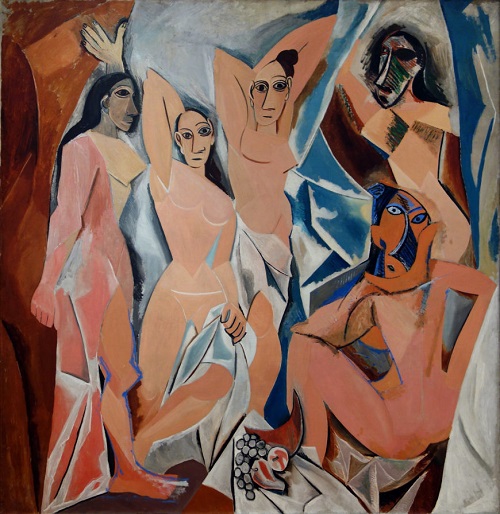Although a work of art can be analyzed on multiple levels and in multiple contexts, several key details are almost always addressed in visual analyses. This will provide helpful questions to ask about a work of art in order to direct attention to the most salient details in the often overwhelming amount of information any one work possesses.
A visual analysis is quite simply an analysis of the forms utilized in the work of art. It is a close inspection of the artist’s use of aspects such as colour, shape, line, and composition.
The visual analysis moves beyond simple description in that it connects the elements of the work to the effects they have on the viewer. Considering this connection enables the viewer to discuss the meaning of the work.
Instructions:

Pablo Picasso, Les demoiselles d’Avignon, 1907, oil on canvas, 8′ x 7′ 8″ (243.9 x 233.7 cm) (Museum of Modern Art, New York, photo: Steven Zucker. CC BY-NC-SA 2.0)
1. Begin with a brief description of the work:
- Who is the artist?
- What is the title?
- What year was it created?
2. Then get into the formal qualities:
- Subject matter:
Describe the actual elements in the work of art (figures, objects: what are we looking at).
- Technique and process:
What are the materials used?
How was it made?
- Line:
How does the artist use line?
Are forms linearly arranged or disordered?
Are there geometric shapes implied by the forms in the piece?
- Shape:
Are the shapes identifiable?
Are they smooth, jagged, consistent?
- Space:
How is the space of the artwork organized?
Is it vast and expansive, or closed and cramped?
- Colour:
How does the artist use colour?
Are there stark contrasts or is it blended?
Are there symbolic meanings behind the colour choices?
- Composition:
What is the overall structure of the artwork?
Is the artwork balanced and harmonious, symmetrical?
Is it asymmetrical?
- Texture:
Describe the textures.
Are they rough, soft, smooth, even, uneven?
Figurative (representational) works:
- Is it naturalistic / realistic?
Depicted in a way that resembles their actual appearance
- Is it idealized?
Depicting an accepted standard of beauty
- Is it stylized?
Nonorganic, opposite of naturalist or realistic
Nonfigurative (nonrepresentational):
- The work does not depict real figures or objects
- Is it abstract?
Depicting forms that do no depict real objects in an accurate way (the subject may be recognizable, but not in a naturalistic way)
